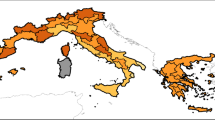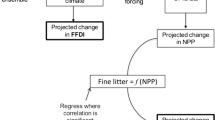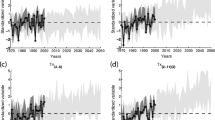Abstract
Historical relationships between weather, the Canadian fire weather index (FWI) system components and area burned in Canadian ecozones were analysed on a monthly basis in tandem with output from the Canadian and the Hadley Centre GCMs to project future area burned. Temperature and fuel moisture were the variables best related to historical monthly area burned with 36–64% of the variance explained depending on ecozone. Our results suggest significant increases in future area burned although there are large regional variations in fire activity. This was especially true for the Canadian GCM where some ecozones show little change in area burned, however area burned was not projected to decrease in any of the ecozones modelled. On average, area burned in Canada is projected to increase by 74–118% by the end of this century in a 3 × CO2 scenario. These estimates do not explicitly take into account any changes in vegetation, ignitions, fire season length, and human activity (fire management and land use activities) that may influence area burned. However, the estimated increases in area burned would have significant ecological, economic and social impacts for Canada.
Similar content being viewed by others
References
Amiro, B. D., Todd, J. B., Wotton, B. M., Logan, K. A., Flannigan, M. D., Stocks, B. J., Mason, J. A., Skinner, W. R., Martell, D. L., and Hirsch, K. G.: 2001, ‘Direct carbon emissions from Canadian forest fires, 1959 to 1999’, Can. J. For. Res. 31, 512–525.
Bergeron, Y. and Flannigan, M. D.: 1995, ‘Predicting the effects of climate change on fire frequency in the southeastern Canadian boreal forest’, Water, Air, Soil Pollut. 82, 437–444.
Brenner, J.: 1991, ‘Southern Oscillation anomalies and their relationship to wildfire activity in Florida’, Int. J. Wildland Fire 1, 73–78.
Ecological Stratification Working Group: 1996, A national ecological framework for Canada, Agriculture and Agri-Food Canada and Environment Canada, Ottawa.
Flannigan, M. D., Bergeron, Y., Engelmark, O., and Wotton, B. M.: 1998, ‘Future wildfire in circumboreal forests in relation to global warming’, J. Vegetat. Sci. 9, 469–476.
Flannigan, M. D., Campbell, I., Wotton, B. M., Carcaillet, C., Richard, P., and Bergeron, Y.: 2001, ‘Future fire in Canada's boreal forest: Paleoecology results, and general circulation model - regional climate model simulations’, Can. J. For. Res. 31, 854–864.
Flannigan, M. D. and Harrington, J. B.: 1988, ‘A study of the relation of meteorological variables to monthly provincial area burned by wildfire in Canada 1953–80’, J. Appl. Meteorol. 27, 441–452.
Flannigan, M. D., Stocks, B. J., and Wotton, B. M.: 2000, ‘Forest fires and climate change’, Sci Total Environ. 262, 221–230.
Flannigan, M. D. and Van Wagner, C. E.: 1991, ‘Climate change and wildfire in Canada’, Can. J. For. Res. 21, 66–72.
Flannigan, M. D. and Wotton, B. M.: 2001, ‘Climate, weather and area burned’, in Johnson, E. A. and Miyanishi, K. (eds.), Forest Fires: Behavior & Ecological Effects, Academic Press, pp. 335–357.
Flannigan, M. D. and Wotton, B. M.: 1989, ‘A study of interpolation methods for forest fire danger rating in Canada’, Can. J. For. Res. 19, 1059–1066.
Flato, G. M., Boer, G. J., Lee, W. G., McFarlane, N. A., Ramsden, D., Reader, M. C., and Weaver, A. J.: 2000, ‘The Canadian Centre for climate modelling and analysis global coupled model and its climate’, Clim. Dynam. 16, 451–467.
Gordon, C., Cooper, C., Senior, C. A., Banks, H., Gregory, J. M., Johns, T. C., Mitchell, J. F. B., and Wood, R. A.: 2000, ‘The simulation of SST, sea ice extents and ocean heat transports in a version of the Hadley Centre coupled model without flux adjustments’, Clim. Dynam. 16, 147–168.
Harrington, J. B.: 1982, A statistical study of area burned by wildfire in Canada 1953–1980. Canadian Forestry Services, Information Report PI-X-16, Petawawa, National Forestry Institute.
Harrington, J. B., Flannigan, M. D., and Van Wagner, C. E.: 1983, A study of the relation of components of the Fire Weather Index System to monthly provincial area burned by wildfire in Canada 1953–80. Canadian Forestry Services, Information Report PI-X-25, Petawawa, National Forestry Institute.
Harvey, D. A., Alexander, M. E., and Janz, B.: 1986, ‘A comparison of fire-weather severity in northern Alberta during the 1980 and 1981 fire seasons’, For. Chron. 62, 507–513.
Hely, C., Flannigan, M. D., Bergeron, Y., and McRae, D.: 2001, ‘Role of vegetation and weather on fire behavior in the Canadian Mixedwood boreal forest using two fire behavior prediction systems’, Can. J. For. Res. 31, 430–441.
Intergovernmental Panel on Climate Change: 2001, Climate Change 2001 The Scientific Basis, Cambridge University Press, Cambridge.
Johnson, E. A.: 1992, Fire and vegetation dynamics: Studies from the North American boreal forest, Cambridge University Press, Cambridge, 125 pp.
Laprise, R., Caya, D., Frigon, A., and Paquin, D.: 2003, ‘Current and perturbed climate as simulated by the second-generation Canadian Regional Climate Model (CRCM-II) over northwestern North America’, Clim. Dynam. 21, 391–404.
Mearns, L. O., Giorgi, F. Mcdaniel, L., and Shields, C.: 1995, ‘Analysis of daily variability of precipitation in a nested regional climate model—comparison with observations and doubled CO2 results’, Global and Planetary Change 10, 55–78.
Newark, M. J.: 1975, ‘The relationship between forest fire occurrence and 500 mb ridging’, Atmosphere 13, 26–33.
Nimchuk, N.: 1983, Wildfire behavior associated with upper ridge breakdown, Alta. Energy and Nat. Resour., For. Serv., Edmonton, AB, Canada. ENR Rep. No. T/50.
Osborn, T. J. and Hulme, M.: 1997, ‘Development of a relationship between station and grid-box rainday frequencies for climate model evaluation’, J. Clim. 10, 1885–1908.
Price, C. and Rind, D.: 1994, ‘The impact of a 2 × CO2 Climate on lightning-caused fires’, J. Clim. 7, 1484–1494.
SAS Institude Inc.: 2000, SAS OnlineDoc™, Version 8, SAS Institude Inc., Cary, NC.
Shabbar, A. and Khandeker, M.: 1996, ‘The impact of El Nino-Southern Oscillation on the temperature field over Canada’, Atmosphere-Ocean 34, 401–416.
Shabbar, A., Bonsal, B., and Khandekar, M.: 1997, ‘Canadian precipitation patterns associated with the southern oscillation’, J. Clim. 10, 3016–3027.
Skelly, W. C. and Henderson-Sellers, A.: 1996, ‘Grid box or grid point: What type of data do GCMs deliver to climate impacts researchers?’, International J. Climatol. 16, 1079–1086.
Skinner, W. R., Flannigan, M. D., Stocks, B. J., Martell, D. M., Wotton, B. M., Todd, J. B. Mason, J. A., Logan, K. A., and Bosch, E. M.: 2001, ‘A 500 mb synoptic wildland fire climatology from large Canadian forest fires, 1959–1996’, Theoret. Appl. Climatol. 71, 157–169.
Skinner, W. R., Stocks, B. J., Martell, D. L., Bonsal, B., and Shabbar, A.: 1999, ‘The association between circulation anomalies in the mid-troposphere and area burned by wildland fire in Canada’, Theoret. Appl. Climatol. 63, 89–105.
Stocks, B. J.: 1993, ‘Global warming and forest fires in Canada’, For. Chron. 69, 290–293.
Stocks, B. J., Fosberg, M. A., Lynham, T. J., Mearns, L., Wotton, B. M., Yang, Q., Jin, J.-Z., Lawrence, K., Hartley, G. R., Mason, J. A., and McKenney, D. W.: 1998, ‘Climate change and forest fire potential in Russian and Canadian boreal forests’, Clim. Change 38, 1–13.
Stocks, B. J., Mason, J. A., Todd, J. B., Bosch, E. M., Wotton, B. M., Amiro, B. D., Flannigan, M. D., Hirsch, K. G., Logan, K. A., Martell, D. L., and Skinner, W. R.: 2002, ‘Large forest fires in Canada, 1959–1997’, J. Geophys. Res. 107, 8149, doi: 10.1029/2001JD000484.
Swetnam, T. W.: 1993, ‘Fire history and climate change in giant sequoia groves’, Science 262, 885–889.
Swetnam, T. W. and Betancourt, J. L.: 1990, ‘Fire-Southern Oscillation relations in the southwestern United States’, Sci. 249, 1017–1020.
Van Wagner, C. E.: 1970, ‘Conversion of Williams severity rating for use with the fire weather index’, Can. Dep. Fisheries and For., Petawawa Forest Expt. Stn., Information Report PS-X-21.
Van Wagner, C. E.: 1987, ‘The development and structure of the Canadian forest fire weather index system’, Canadian Forest Service, Forest Technical Report 35, Ottawa, Canada.
Weber, M. G. and Flannigan, M. D.: 1997, ‘Canadian boreal forest ecosystem structure and function in a changing climate: Impacts on fire regimes’, Environ. Rev. 5, 145–166.
Weber, M. G. and Stocks, B. J.: 1998, ‘Forest fires and sustainability in the boreal forests of Canada’, Ambio 27, 545–550.
Williams, D. E.: 1959, ‘Fire season severity rating’, Can. Dep. Northern Aff. And Nat. Res., Div. Tech. Note 73, Ottawa, Canada.
Wotton, B. M. and Flannigan, M. D.: 1993, ‘Length of the fire season in a changing climate’, For. Chron. 69, 187–192.
Wotton, B. M., Martell, D. L., and Logan, K. A.: 2003, ‘Climate change and people-caused forest fire occurrence in Ontario’, Clim. Change 60, 275–295.
Author information
Authors and Affiliations
Corresponding author
Rights and permissions
About this article
Cite this article
Flannigan, M.D., Logan, K.A., Amiro, B.D. et al. Future Area Burned in Canada. Climatic Change 72, 1–16 (2005). https://doi.org/10.1007/s10584-005-5935-y
Received:
Revised:
Issue Date:
DOI: https://doi.org/10.1007/s10584-005-5935-y




